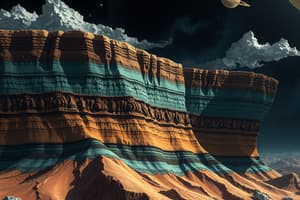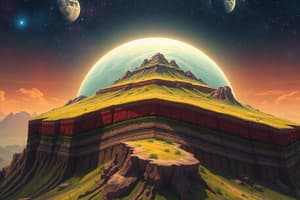Podcast
Questions and Answers
What is the approximate thickness range of the Earth's crust?
What is the approximate thickness range of the Earth's crust?
- 50-100 km
- 200-500 km
- 10-20 km
- 5-70 km (correct)
What is the dominant element composition of the Earth's core?
What is the dominant element composition of the Earth's core?
- Calcium and Magnesium
- Iron and Nickel (correct)
- Oxygen and Hydrogen
- Silicon and Aluminum
Which layer of the Earth is composed of molten rock?
Which layer of the Earth is composed of molten rock?
- Crust
- Mantle (correct)
- Asthenosphere
- Lithosphere
What is the general temperature range in the mantle?
What is the general temperature range in the mantle?
The lithosphere is characterized by which of the following?
The lithosphere is characterized by which of the following?
What is the main difference between abiogenesis and biogenesis?
What is the main difference between abiogenesis and biogenesis?
Which characteristic of organisms refers to their ability to create offspring?
Which characteristic of organisms refers to their ability to create offspring?
Who proposed the theory of spontaneous generation?
Who proposed the theory of spontaneous generation?
What scientific principle explains that all living organisms are made of cells?
What scientific principle explains that all living organisms are made of cells?
Which of the following best describes metabolism?
Which of the following best describes metabolism?
What was Jan Baptist van Helmont's contribution to the theory of spontaneous generation?
What was Jan Baptist van Helmont's contribution to the theory of spontaneous generation?
Which theory suggests that life could have come from extraterrestrial sources?
Which theory suggests that life could have come from extraterrestrial sources?
Which of the following is NOT a characteristic of living organisms?
Which of the following is NOT a characteristic of living organisms?
Who was the scientist that demonstrated maggots are produced from the eggs of flies, disproving the theory of spontaneous generation?
Who was the scientist that demonstrated maggots are produced from the eggs of flies, disproving the theory of spontaneous generation?
What was a key flaw in John Turberville Needham's experiment on spontaneous generation?
What was a key flaw in John Turberville Needham's experiment on spontaneous generation?
Which scientist is known for the phrase 'Omne vivum ex vivo', meaning 'life only comes from life'?
Which scientist is known for the phrase 'Omne vivum ex vivo', meaning 'life only comes from life'?
Lazzaro Spallanzani's conclusions primarily emphasized that life arises from what source?
Lazzaro Spallanzani's conclusions primarily emphasized that life arises from what source?
What theory posits that life on Earth originated from a celestial source like a meteorite?
What theory posits that life on Earth originated from a celestial source like a meteorite?
Which of the following scientists is not credited with disproving the theory of spontaneous generation?
Which of the following scientists is not credited with disproving the theory of spontaneous generation?
What primary conclusion did Louis Pasteur's experiments reach regarding life?
What primary conclusion did Louis Pasteur's experiments reach regarding life?
What does the Primordial Soup Theory suggest about the origin of life?
What does the Primordial Soup Theory suggest about the origin of life?
According to the Primordial Soup Theory, how did life on Earth begin?
According to the Primordial Soup Theory, how did life on Earth begin?
Which of the following statements is true regarding living organisms?
Which of the following statements is true regarding living organisms?
What was Louis Pasteur known for in relation to spontaneous generation theory?
What was Louis Pasteur known for in relation to spontaneous generation theory?
Which theory suggests that life on Earth may have originated from extraterrestrial sources?
Which theory suggests that life on Earth may have originated from extraterrestrial sources?
How does abiogenesis differ from biogenesis?
How does abiogenesis differ from biogenesis?
Which characteristic is NOT a feature of living organisms?
Which characteristic is NOT a feature of living organisms?
What is the primary focus of life science as a discipline?
What is the primary focus of life science as a discipline?
Which of the following is a significant contribution of Louis Pasteur to the study of life?
Which of the following is a significant contribution of Louis Pasteur to the study of life?
Flashcards
Earth's crust thickness
Earth's crust thickness
The Earth's crust is approximately 5 to 70 kilometers thick.
Core composition
Core composition
The Earth's core primarily consists of iron and nickel.
Molten layer
Molten layer
The mantle is a layer of molten rock.
Mantle temperature range
Mantle temperature range
Signup and view all the flashcards
Lithosphere properties
Lithosphere properties
Signup and view all the flashcards
What is Life Science?
What is Life Science?
Signup and view all the flashcards
What are the characteristics of living organisms?
What are the characteristics of living organisms?
Signup and view all the flashcards
How do living things respond to their environment?
How do living things respond to their environment?
Signup and view all the flashcards
What is the difference between growth and development?
What is the difference between growth and development?
Signup and view all the flashcards
Reproduction
Reproduction
Signup and view all the flashcards
What is metabolism?
What is metabolism?
Signup and view all the flashcards
Homeostasis
Homeostasis
Signup and view all the flashcards
What is the basic unit of life?
What is the basic unit of life?
Signup and view all the flashcards
Primordial Soup Theory
Primordial Soup Theory
Signup and view all the flashcards
Life Science
Life Science
Signup and view all the flashcards
Organism
Organism
Signup and view all the flashcards
Growth & Development
Growth & Development
Signup and view all the flashcards
Adaptation
Adaptation
Signup and view all the flashcards
Movement
Movement
Signup and view all the flashcards
Metabolism
Metabolism
Signup and view all the flashcards
Spontaneous Generation
Spontaneous Generation
Signup and view all the flashcards
Francesco Redi's Experiment
Francesco Redi's Experiment
Signup and view all the flashcards
John Turberville Needham's Experiment
John Turberville Needham's Experiment
Signup and view all the flashcards
Lazzaro Spallanzani's Experiment
Lazzaro Spallanzani's Experiment
Signup and view all the flashcards
Louis Pasteur's Experiment
Louis Pasteur's Experiment
Signup and view all the flashcards
Omne Vivum ex Vivo
Omne Vivum ex Vivo
Signup and view all the flashcards
Panspermia Theory
Panspermia Theory
Signup and view all the flashcards
Study Notes
Crust
- Outermost layer of the Earth, serves as the surface for life.
- Thinnest layer, ranging from 5 to 70 km in thickness.
- Average surface temperature around 59°F (15°C).
- Composes only 1% of Earth’s total mass.
- Directly interacts with the atmosphere.
- Made primarily of solid rock, predominantly basalt and granite.
Lithosphere
- Encompasses the outer layer of the Earth, combining the crust and upper mantle.
- Consists of rigid rocks that are divided into tectonic plates.
- Includes rocks and soil essential for terrestrial ecosystems.
Mantle
- Thickest layer of the Earth, extending about 2900 km in thickness.
- Temperature fluctuates between 1600°F and 4000°F.
- Contains 66% of Earth’s total mass, showcasing significant volume.
- Features slow flow due to convection processes within this layer.
- Composed mainly of molten rock (magma), allowing for dynamic movements.
Asthenosphere
- Located in the middle mantle, characterized by solid but flowing rock.
- Acts as a semi-fluid layer permitting tectonic plates of the lithosphere to move atop it.
Core
- Innermost layer, extremely hot with temperatures ranging from 4000°F to 8000°F.
- Notable for its high density and immense pressure, being 4000 miles from the Earth's surface.
- Accounts for 33% of Earth’s total mass.
- Made predominantly of iron and nickel, key metals that contribute to Earth's magnetic field.
- Roughly the same size as the planet Mars, highlighting its significant volume in comparison to the rest of the Earth.
Studying That Suits You
Use AI to generate personalized quizzes and flashcards to suit your learning preferences.




